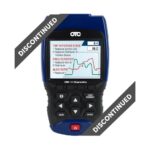The On-Board Diagnostics (OBD) system is a crucial component in modern vehicles, responsible for monitoring engine performance and emissions. Understanding the Difference Between Obd And Obd2 Ports is essential for vehicle owners and mechanics alike. This article delves into the distinctions between these two systems, highlighting their functionalities and evolution.
Evolution of On-Board Diagnostics: From OBD to OBD2
OBD systems were initially introduced in the early 1990s to address growing concerns about vehicle emissions. The first generation, OBD1, provided basic diagnostic capabilities, primarily focusing on emissions-related components. However, OBD1 lacked standardization, with manufacturers using different protocols and connectors. This inconsistency made diagnostics challenging and required specialized equipment for each vehicle make and model.
In 1996, a significant advancement came with the introduction of OBD2 in the United States. This standardized system revolutionized vehicle diagnostics by implementing a universal connector, the OBD2 port, and a common communication protocol. This standardization enabled mechanics to use a single OBD2 scanner to diagnose vehicles from different manufacturers.
Key Differences Between OBD and OBD2 Ports
The most noticeable difference lies in the connector itself. OBD1 systems utilized various connectors depending on the manufacturer, making universal diagnostics impossible. In contrast, OBD2 features a standardized 16-pin trapezoidal connector, readily identifiable under the dashboard on the driver’s side.
Beyond the physical connector, OBD2 boasts significant improvements in functionality:
- Expanded Monitoring: OBD2 monitors a broader range of vehicle systems, including engine performance, emissions, transmission, ABS, and airbags. This comprehensive approach allows for more thorough diagnostics.
- Standardized Communication: OBD2 employs a standardized communication protocol, enabling seamless data retrieval with any OBD2 scanner. This universality simplifies diagnostics and eliminates the need for manufacturer-specific tools.
- Enhanced Data: OBD2 provides access to more detailed data, including real-time sensor readings, freeze frame data (snapshot of vehicle parameters at the time of a fault), and diagnostic trouble codes (DTCs). This richer data set facilitates accurate and efficient troubleshooting.
- Emissions Focus: OBD2 places a greater emphasis on emissions monitoring and compliance with environmental regulations. It can detect a wider array of emissions-related faults, contributing to cleaner air.
EOBD and EOBD2: European Counterparts
Europe adopted similar standards with EOBD (European On-Board Diagnostics), mirroring OBD2 functionalities and becoming mandatory for gasoline vehicles in 2001 and diesel vehicles in 2004. EOBD2, a more recent iteration, expands upon EOBD with stricter emissions standards and enhanced diagnostic capabilities. While minor differences exist between OBD2 and EOBD/EOBD2, they are largely compatible, allowing OBD2 scanners to function effectively on European vehicles.
Benefits of OBD2
The standardization and enhanced capabilities of OBD2 offer numerous benefits:
- Simplified Diagnostics: Universal connector and protocol make troubleshooting easier for mechanics.
- Reduced Repair Costs: Early detection of issues through comprehensive monitoring prevents costly damage.
- Improved Emissions Control: Stringent monitoring and fault detection contribute to lower vehicle emissions.
- Enhanced Vehicle Performance: Identifying and addressing performance issues optimizes engine efficiency.
Conclusion
The transition from OBD to OBD2 represents a significant leap in vehicle diagnostics. The standardized OBD2 port and protocol have simplified troubleshooting, improved emissions control, and empowered vehicle owners with greater insight into their vehicle’s health. Understanding the difference between these systems is essential for effective vehicle maintenance and repair.

